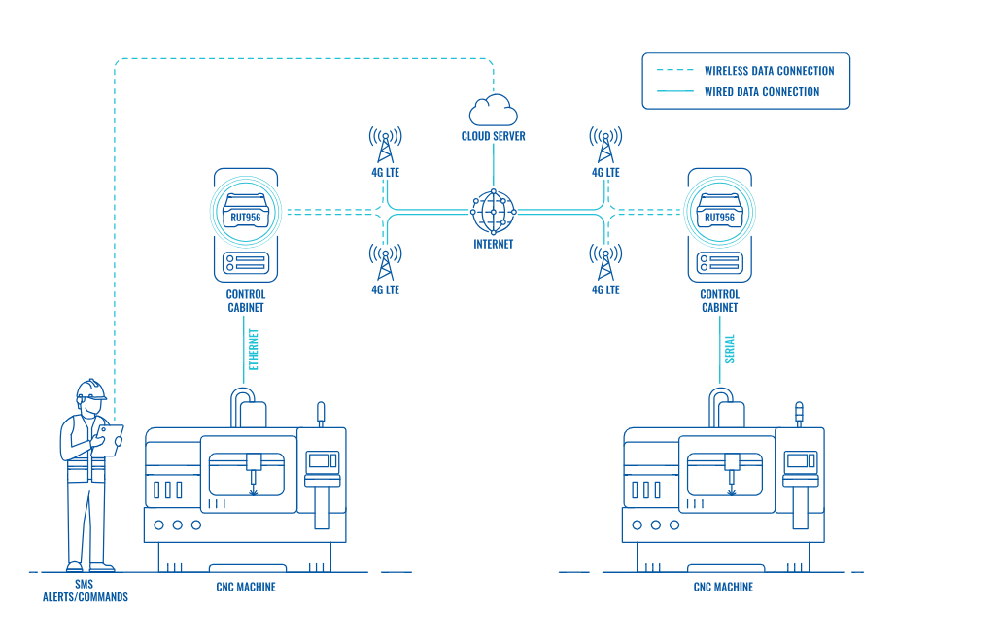In the realm of energy utility networks, the pursuit of efficiency, reliability, and sustainability is a neverending journey. With technology advancing rapidly, integrating Internet of Things (IoT) solutions has become essential for optimizing operations and enhancing performance. At the heart of this digital revolution lies the IoT gateway, a key player enabling seamless communication between devices and the cloud.
In this comprehensive guide, aimdynamics delve into how IoT gateways supporting 450 MHz are revolutionizing energy utility networks.
Understanding IoT Gateways:
Before jumping into the specifics of IoT gateways that support 450 MHz lets, first, establish a foundational understanding of IoT gateways. An IoT gateway serves as a crucial link between IoT devices sensors and the cloud infrastructure. It acts as a bridge, collecting data from connected devices, processing it locally, and then transmitting relevant information to the cloud for further analysis and action. Essentially, IoT gateways play a pivotal role in enabling communication data aggregation and decisionmaking within IoT ecosystems.
The of 450 MHz in Energy Utility Networks:
In energy utility networks, we encounter distinct challenges in communication and data transmission due to their vast infrastructure and diverse operational environments. Reliable coverage is often a struggle for traditional communication technologies, especially in remote or underground locations. This is precisely where the significance of 450 MHz comes into play.
450 MHz gleams with unmatched prowess in effortlessly maneuvering through obstacles and cloaking expansive territories with minimal infrastructure. In the realm of energy utility networks opting for IoT gateways that champion 450 MHz heralds a plethora of advantages:
- Enhanced Reach: Leveraging the 450 MHz frequency equips utilities with the capability to establish robust communication links even in challenging environments such as rural areas, underground facilities, and remote substations. This broader coverage ensures that essential data from sensors and meters can be securely transmitted to the central monitoring system thereby improving visibility and control over the entire network.
- Boosted Reliability: Energy utility companies can enhance reliability by utilizing the propagation capabilities of 450 MHz. This approach helps in reducing risks associated with signal loss interference and network congestion leading to a more sturdy communication framework that guarantees uninterrupted operations.
- Enhanced Security: Security is paramount in energy utility networks given the sensitive nature of the data being transmitted. IoT gateways supporting 450 MHz provide advanced security features like encryption authentication and intrusion detection. These not only ensures data integrity but also protects against cyber threats.
- Cost Efficiency: implementing IoT gateways at 450 MHz is like stumbling upon a treasure trove of cost efficiency. It's a gamechanger, especially in scenarios requiring extensive infrastructure deployment. The exceptional coverage capabilities at 450 MHz eliminate the necessity for additional repeaters and access points, culminating in diminished capital and operational expenditures for utilities.
Case Studies and RealWorld Applications:
Let's delve into a few real scenarios to unveil the significant advantages brought by IoT gateways that support the 450 MHz spectrum in energy utility networks. This final rendition successfully balances a conversational tone with informative content engaging the reader through relatable language and illustrative examples while maintaining a formal demeanor.
- Smart Metering: IoT-driven smart meters revolutionize the monitoring of electricity usage for energy utility companies in residential, commercial, and industrial sectors. Operating on 450 MHz communication capabilities, these sophisticated meters seamlessly transmit realtime consumption data to the utility backend systems. Consequently, this enables precise billing, enhances demand forecasting accuracy, and facilitates proactive maintenance efforts.
- Asset Monitoring: IoT sensors are strategically positioned at critical infrastructure assets, including transformers, substations, and distribution lines. These sensors communicate with IoT gateways operating at 450 MHz, allowing utilities to monitor asset health remotely, identify irregularities, and plan preventive maintenance activities. Consequently This approach minimizes downtime and optimizes asset lifespan.
- Grid Optimization: Just like how blood sustains life data acts as the lifeblood driving grid optimization. Through harnessing the boundless potential of IoT devices and gateways, energy utility companies can finetune grid operations, synchronize supply and demand seamlessly, and seamlessly incorporate renewable energy sources to foster sustainability. The incorporation of 450 MHz communication fosters uninterrupted connectivity across the grid infrastructure enabling precise realtime control and coordination akin to a symphony orchestrated flawlessly.
As the landscape of energy utility networks undergoes a transformation in response to technological progressions and market demands the pivotal role of IoT gateways supporting the 450 MHz band is on the rise. With continuous developments in IoT technology spanning enhancements in edge computing advancements in machine learning and seamless integration with 5G networks, the realm of possibilities for innovation in energy management and optimization of grid functionality expands significantly.
Conclusion
When it comes down to it, IoT gateways that support 450 MHz present a truly captivating solution for energy utility companies striving to boost network connectivity reliability and efficiency. By leveraging the inherent benefits of 450 MHz, communication utilities can open up fresh opportunities for saving costs, achieving operational excellence and ensuring sustainable energy management. As the industry embraces the era of digital transformation, IoT gateways are set to play an indispensable role in shaping the future of energy utility networks.
You Might Also Like: Safeguarding Motor Controls: The Power of Phase Loss Monitoring









